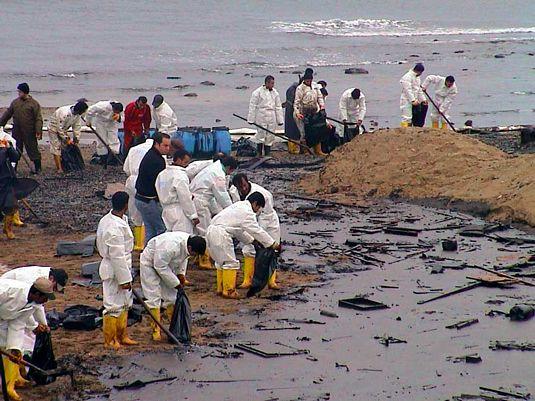
BP’s blownout Deepwater Horizon well gushed up to 2.6 million gallons a day, the federal government now says, a total equivalent of 19 Exxon Valdezes. For months, BP insisted the figure of 1,000 then 5,000 barrels a day. BP will be responsible for a $17.6 billion fine – $4,300 for each barrel of oil, less the 800,000 barrels directly siphoned from the well-head. BP’s leaking well gushed 62,000 barrels of oil a day, the federal government said Monday in a revision of its figures that reveals how far off initial estimates turned out to be. The new estimate Monday by federal scientists means 4.9 million barrels of oil likely were released by the well before it was temporarily capped last month.
Meanwhile, Republicans are expected to filibuster legislation this week that would reform the oil industry to prevent another such disaster. [1 bbl (barrel) = 42 gallons; 4.9 million barrels total = 205.8 million gallons total ! ]
How much damage has the BP oil spill done?
13 July 2010 By Finlo Rohrer BBC News, Washington
In the months since the start of the BP oil spill in the Gulf of Mexico there have been harrowing images of birds coated in oil and dead dolphins
There may be oil which becomes buried on shore, and oil may end up at the bottom of the sea in anaerobic areas – places where there is no oxygen to allow the microbes to do their work.
“We have never seen these clouds or plumes of oil dispersed in tiny droplets in the water,” says Mr Senner. “We don’t know how much is ending up on the bottom. Onshore, we don’t know how much is being buried.”
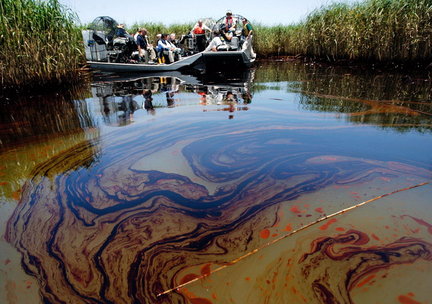
“If the oil has penetrated the wetlands down to the roots, then you are going to lose those areas altogether. [Wetlands] will go to open water and will never recover.” “The wetlands that are already impacted, if only the stems and the grass you see on the surface are affected then the recovery will be within one or two years,” says Dr Larry McKinney, director of the Harte Research Institute for Gulf of Mexico Studies. It’s hard at this juncture to tell what the eventual effect will be on the northern Gulf Coast’s habitat.
“With events like this their impacts occur in different phases,” says Mr Senner. First there is the initial wave of deaths, the animals that get covered in oil and die.
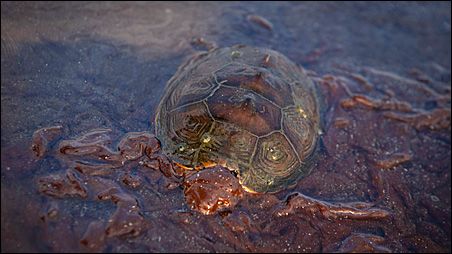
The death toll Mr Senner is aware of already includes a “thousand bird carcasses – half of them are oiled, others are just carcasses, a few hundred turtles, 50 or so dolphins”.
But those small numbers reflect the fact that only a small percentage of carcasses are recovered.
“The assumption is that the actual mortality rate is many times what has been recovered,” says Mr Senner. “The rule of thumb for the bird carcasses is that they find one in 10, but that could be low.”
The question everybody will be asking is how quickly can animal numbers return to normal. It all depends on the life span of the animal.
In the Ixtoc spill of 1979, there was a 60-70% reduction in shrimp in the year of the spill, but they were back to normal within one or two years, says Dr McKinney.
Then there are longer-lived animals like dolphins, whale sharks and sea turtles. If a single generation has been largely wiped out, numbers might not fully recover for 10-20 years.
And then there are the truly long-lived organisms.
“For deepwater solitary coral communities, their lifespan is in hundreds of years,” says Dr McKinney.
They could potentially be vulnerable to the oil or to patches of oxygen-depleted water created by the oil-eating microbes. When the microbes degrade the oil, oxygen is used up and carbon dioxide is produced.
Dr McKinney is worried about “huge clouds of low-oxygen oil dispersant mix, [which is] methane-heavy”.
The plus side for fish stocks on the other hand is that, severe as the damage might be, it will be mitigated by the break in fishing.
“They have closed such large areas of the Gulf that the pressure has been reduced,” says Dr McKinney. “Reducing the fishing pressure will allow more fish to remain alive and reproduce.”
So stocks of fish like red snapper could be back to normal within two to four years.
The effect of the spill on species that are already under immense pressure – like Atlantic bluefin tuna – could be severe.
“In ecosystems, when you wipe out large segments of them, the ecosystem responds to the absence of those things and other things come in to take their place and you don’t return to the way things were,” says Mr Senner. “Ecosystems are always dynamic. What we see in the Gulf of Mexico is an ecosystem that already had a number of stresses on it.”
Some animals and plants may be badly affected by the disruption of the spill and not regain their previous place in the ecosystem once conditions return to normal. But they will be replaced by other organisms.
THE UNKNOWN
A lot of the thinking about the effects of the BP oil spill is informed by the work done following the Ixtoc spill of 1979. But there are some aspects of the latest spill about which scientists find it hard even to speculate.
Marine biologists will admit that not a great deal is known about the effects of oil on organisms in deep water. “We know almost nothing about the ecology in the deep ocean,” says Prof Overton. It may offer only a crumb of comfort, but the 2010 spill will one day provide that knowledge.
COLLEEN LONG, HARRY R. WEBER Associated Press Writers – 3:29 p.m. EDT, July 16, 2010
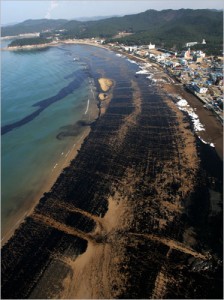
NEW ORLEANS (AP) – BP said its capped-off well appeared to be holding steady Friday as a white-knuckle waiting period ticked by with engineers watching pressure gauges for signs of a leak.
Results monitored from control rooms on ships at sea and hundreds of miles away at the company’s U.S. headquarters in Houston showed the oil staying inside the cap, rather than escaping through any undiscovered breaches, BP PLC vice president Kent Wells said on a morning conference call.
Four underwater robots scoured the sea floor but had also found no signs of new leaks, he said.
BP and government scientists huddled Friday afternoon to discuss the first 24 hours of pressure readings as they sought to determine whether they can keep the gusher sealed off or have to release some of the flow and funnel it up to vessels on the surface.
What comes out of that meeting could help shape the remainder of the test, according to a BP official with direct knowledge of the operations who spoke on condition of anonymity because the integrity test was at a sensitive stage.
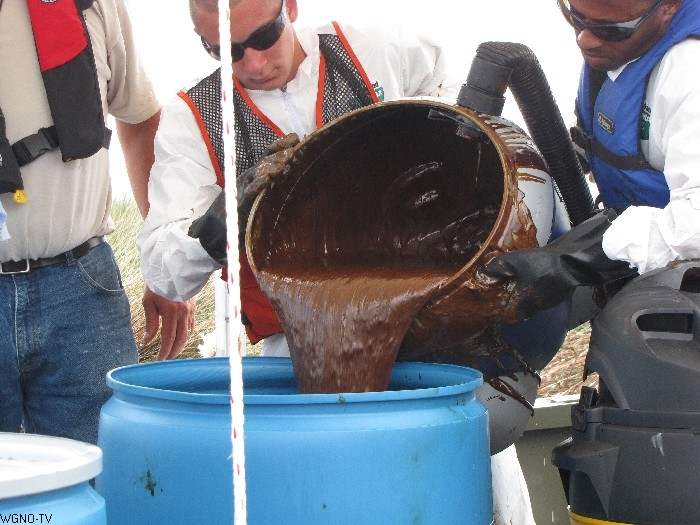 President Barack Obama said Friday the progress was good news, but cautioned an anxious public not to “get too far ahead of ourselves.” Obama said the cap was still being tested and there was still an “enormous clean up job” and ensuring quick compensation for Gulf residents and business in the offing.
President Barack Obama said Friday the progress was good news, but cautioned an anxious public not to “get too far ahead of ourselves.” Obama said the cap was still being tested and there was still an “enormous clean up job” and ensuring quick compensation for Gulf residents and business in the offing.
There was no evidence of a leak in the pipe under the sea floor, Wells said, one of the main concerns. Wells said the results were encouraging 17 hours after valves were shut to trap oil inside the cap, a test that could last up to 48 hours.
He said pressure continued to rise inside the tight-fighting cap, a good sign that oil was not getting out somewhere else. The pressure was more than 6,700 pounds per square inch, above the minimum they were hoping to see, but not yet in the high range of 8,000 to 9,000 psi they were hoping for.
“The pressures we’ve seen so far are consistent with the engineering analysis work that BP has done,” Wells said. “It’s been a very steady build.”
Wells also said work would resume on a relief well, the oil giant’s more permanent solution meant to plug the leak for good underground to end one of the nation’s worst environmental catastrophes.
That’s also a sign that things were going well. Engineers had stopped drilling one of the wells Thursday in case that bore hole deep underground could be affected by the oil cap effort.
Engineers and scientists continue to monitor the cap’s pressure. When the test is complete, more sea floor mapping will be done to detect any damage or deep-water leaks.
BP finally stopped oil from spewing into the sea Thursday for the first time since an April 20 explosion on the BP-leased Deepwater Horizon oil rig killed 11 workers and unleashed the spill 5,000 feet beneath the water’s surface.
The accomplishment was greeted with hope, high expectations – and, in many cases along the beleaguered coastline, disbelief. BP Chief Operating Officer Doug Suttles urged caution and warned the flow could resume, saying it wasn’t a time for celebration.
There was no end in sight to cleaning the oil already in the water and on shore. Somewhere between 94 million and 184 million gallons spilled into the Gulf, according to government estimates.
Long strands of white absorbent boom strung along the beach were stained chocolate brown at Orange Beach, Ala., early Friday after a fresh wave of pea-sized tar balls washed ashore. Charter boat captains who can’t fish because of the oil spill patrolled the shore looking for more oil slicks.
A few miles away, an oily sheen swirled around a $4.6 million steel oil barrier erected at the pass into Perdido Bay, located near the Alabama-Florida border.
Orange Beach Mayor Tony Kennon said shutting the well meant a light at the end of the tunnel, but the damage is done.
“The other side is they’re not paying claims and I’m watching people moving away, people losing their jobs, everything they’ve got. How can I be that happy when that’s happening to my neighbor?”
Kennon said BP has only paid $50,000 of his city’s claim of $1.9 million for damages and response.
“They told us that they’re cutting us a check for $14,000, which is pretty much a slap in the face” said Dea Baxter, office manager for Griffin Fishing, a recreational charter fishing service in Lafitte. “We’ve sent more than that out in refunds and cancellations.”
BP said Friday it has paid out $201 million so far to individuals and businesses. It said more than 32,000 claimants got one or more payments in the past 10 weeks.
More than 114,000 claims have been submitted so far, but nearly half didn’t have enough information for BP to make payment, the oil giant said.
On Pensacola Beach in Florida, dozens of BP workers in neon vests operated heavy equipment up and down the beach throughout the night and early morning. Workers used shovels and rakes to comb through the sands for pieces of tar. Other workers then collect the clumps of tar in bags, which are carried by the front-end loaders to dump trucks and hauled away down the beach.
BP said the decision on whether to reopen the well after the test would be made by the government’s national incident command, run by retired Coast Guard Adm. Thad Allen.
It’s not clear yet whether the oil will remain bottled in the cap after the test, or whether BP will use the device to funnel the crude into four ships on the surface.
The cap is a temporary measure until the gusher can be plugged deep underground, where a seal will hold better than by blocking the powerful gusher from the top. BP plans to shoot cement and heavy drilling mud into the well from one of the two relief it is drilling.
The 48-hour watch period started at 3:25 p.m. EDT when the last of three valves in the 75-ton cap was slowly throttled shut.
It came after repeated attempts to stop the oil – everything from robotics to different capping techniques to stuffing the hole with mud and golf balls. The week leading up to the moment where the oil cloud ended was a fitful series of starts and setbacks.
BP officials have said repeatedly they were right to take a step-by-step approach to trying to shut off the geyser over the last three months, to make sure they didn’t make the disaster worse. They have also pointed out that the current cap system in place took time to design and build and to make sure it could withstand the massive water pressures a mile below the sea.
BP removed a previous, looser cap last weekend, at which point oil flowed freely into the water. Robotic submarines swarmed the site to unbolt a busted piece of pipe and install a connector atop the spewing well bore – and by Monday the 75-ton metal cap, a stack of lines and valves, was latched onto the busted well.
After that, engineers spent hours creating a map of the rock under the sea floor to spot potential dangers, like gas pockets. They also shut down two ships collecting oil above the sea to get an accurate reading on the pressure in the cap.
As the oil flowed up to the cap, two valves were shut off like light switches, and the third dialed down like a dimmer switch until it too was choked off.
And just like that, the oil stopped.
The news was met with a mix of joy, skepticism and disbelief from beleaguered Gulf Coast residents. A quiet optimism started to take hold.
Richard Forester, executive director of the Mississippi Gulf Coast Convention and Visitors Bureau, said it’s possible the season can be saved.
“Fortunately, we are still seeing pretty good occupancy because most people recognize we are so much more than a beach destination,” Forester said. “The oil spill has had an impact on our beachfront hotels, charter operations, vendors, gift shops. Whether or not they’ve stopped it, there’s still a lot of oil out there that’s got to be cleaned up.”
The Gulf Coast has been shaken economically, environmentally and psychologically by the hardships of the past three months. That feeling of being swatted around – by BP, by the government, even by fate – was evident in the wide spectrum of reactions to news of the capping.
The fishing industry in particular has been buffeted by fallout from the spill. Surveys of oyster grounds in Louisiana showed extensive deaths of the shellfish. Large sections of the Gulf Coast – which accounts for 60 to 70 percent of the oysters eaten in the United States – have been closed to harvesting.
The saga has also devastated BP, costing it billions in everything from cleanup to repair efforts to plunging stock prices. BP shares, which have lost nearly half their value since the disaster started, jumped in the last hour of Thursday trading on Wall Street after the oil stopped. But they were down again more than 3 percent Friday morning.
Long after the well is finally plugged, oil could still be washing up in marshes and on beaches as tar balls or disc-shaped patties. The sheen will dissolve over time, scientists say, and the slick will convert to another form.
There’s also fear that months from now, oil could move far west to Corpus Christi, Texas, or farther east and hitch a ride on the loop current, possibly showing up as tar balls in Miami or North Carolina’s Outer Banks.
_______
Weber reported from Houston. Associated Press Writers Shelia Byrd in Jackson, Miss., Jay Reeves in Orange Beach, Ala., Kevin McGill in New Orleans, Jennifer Garske King in Washington, Matt Sedensky in Pensacola, Fla., and Ramit Plushnick-Masti in New Orleans contributed to this report.
the U.S. taxpayer paid BP to lease a rig
BP used oil industry tax break to write off its rent for Deepwater rig.
Transocean, the company that owns the failed Deepwater Horizon rig that caused the Gulf oil spill, used well-known tax havens in the Cayman Islands and Switzerland to lower its U.S. corporate tax rate by almost 15 points. And due to a break in the U.S. tax code, BP was also allowed to write off the rent it paid to Transocean on its own tax bill, saving it hundreds of thousands of dollars per day:
The owner, Transocean, moved its corporate headquarters from Houston to the Cayman Islands in 1999 and then to Switzerland in 2008, maneuvers that also helped it avoid taxes. At the same time, BP was reaping sizable tax benefits from leasing the rig. According to a letter sent in June to the Senate Finance Committee, the company used a tax break for the oil industry to write off 70 percent of the rent for Deepwater Horizon – a deduction of more than $225,000 a day since the lease began.
So, essentially, the U.S. taxpayer paid BP to lease a rig that was incorporated in a foreign country for the purpose of avoiding the U.S. corporate tax. And the U.S. tax code is actually riddled with breaks for the oil industry, despite that industry’s record profits in recent years. Center for American Progress Senior Policy Analyst Sima Gandhi has counted nine different subsidies that the U.S. government gives to the oil industry, including refunds for drilling costs and refunds to cover the cost of searching for oil. If this corporate welfare were cut, it would save $45 billion per year, and according to the Office of Economic Policy at the Department of Treasury, “affect domestic production by less than one-half of 1 percent.” “The flow of revenues to oil companies is like the gusher at the bottom of the Gulf of Mexico: heavy and constant,” said Sen. Robert Menendez (D-NJ). “There is no reason for these corporations to shortchange the American taxpayer.”





